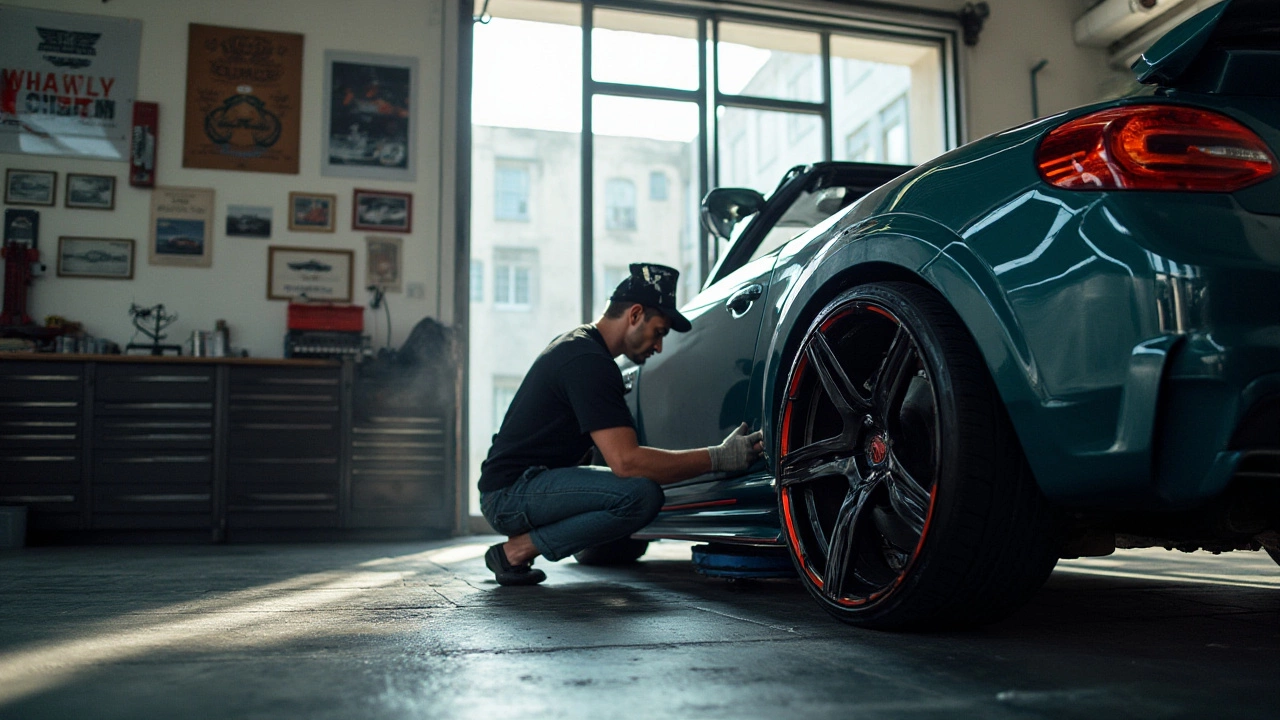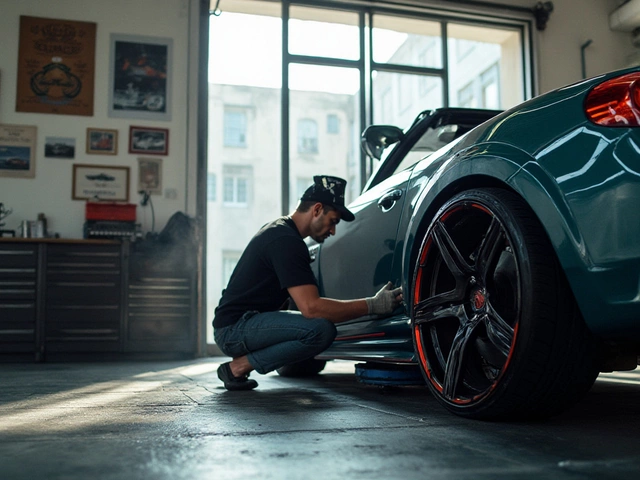Wheel spacers have become a popular modification for car enthusiasts looking to tweak their vehicle's stance and enhance handling capabilities. While they can certainly help in achieving a look or performance characteristic drivers may desire, they do not come without disadvantages. Many drivers aren't fully aware of the implications these small additions to their wheels can have.
It's crucial to delve into the potential risks and drawbacks associated with the use of wheel spacers. Whether you're a seasoned car modifier or someone curious about how these modifications could impact your ride, taking a closer look at the hidden costs might save you trouble down the road. From safety hazards to mechanical stresses, knowing what's at stake is key to making an informed choice.
- Introduction to Wheel Spacers
- Safety Concerns with Wheel Spacers
- Mechanical Impacts of Using Spacers
- Potential Legal Considerations
- Practical Tips for Safe Spacer Use
Introduction to Wheel Spacers
When it comes to modifying vehicles, wheel spacers often find themselves in both the spotlight and the shadows of debate. These small mechanical devices are inserted between the wheel hub and the wheel itself. The primary function of a wheel spacer is to increase the distance between the wheel and the wheel hub assembly. This might sound simple, yet these spacers play a crucial role in both the aesthetics and mechanics of a vehicle. For car enthusiasts, the allure of flush wheels—where the wheels are in alignment with the fenders—is irresistible, and spacers provide a relatively straightforward way to achieve this look without the need for a completely new set of rims.
The primary appeal of using wheel spacers lies in their ability to alter a vehicle's stance and handling characteristics. By extending the wheels further out, drivers may find improved handling due to a wider track. This can potentially enhance the car's cornering grip, making everyday driving or spirited takes on winding roads feel more engaging. According to a well-known auto magazine, "The benefits of a wider stance cannot be understated when it comes to grip and stability." This subtle change can also impact a vehicle's center of gravity, with potentially beneficial effects on performance and ride comfort.
That being said, the influence of wheel spacers isn't just about performance or aesthetics. They can address certain mechanical issues as well, such as ensuring a specific tire and wheel combination fits properly without rubbing against suspension components, fenders, or brakes. This flexible mechanical solution can save money when a perfect fit isn't achieved, avoiding the purchase of expensive custom wheels. It's also worth noting that spacers can assist with brake caliper clearance concerns, especially when performance brake kits are installed that require additional space.
Using Spacers on the Track vs. the Street
Interestingly, the application of wheel spacers can vary based on the intended use of the vehicle. Track-centric cars may utilize spacers to enhance grip and handling dynamics for shorter bursts of speed. In contrast, daily drivers often employ spacers to achieve a desired look while considering the impact on drive comfort and safety. Each use case offers its unique perspective on their advantages and potential drawbacks.
Of course, it's not all straightforward, and understanding the specific type required—bolt-on or slip-on—is essential for proper fitment and safety. Whether a driver opts for one-piece spacers or modular systems, there can be differences in how they affect the vehicle. Many car owners often overlook the need for extended wheel bolts or studs, which is a necessary modification for appropriate installation to guarantee the wheels sit correctly and securely. Comprehending the interplay of all these elements establishes whether or not wheel spacers are a viable option for a particular vehicle.
Safety Concerns with Wheel Spacers
When contemplating the addition of wheel spacers to a vehicle, delving into the potential safety hazards is not just prudent, it’s necessary. While they may boost the aesthetics and provide better handling, wheel spacers can create issues if not used properly. One of the prevailing concerns relates to the altered geometry of the vehicle's suspension and steering system. By moving the wheels outward, the load path is shifted, leading to increased stress on the wheel bearings and axles. This increased tension can eventually lead to premature wear or even catastrophic failure if unchecked. Maintaining regular inspections and ensuring the vehicle is not overloaded can mitigate these risks.
Another critical safety issue is the diminished capacity for wheel fasteners to remain tight. Vehicle safety could be compromised if spacers are improperly installed, resulting in loose bolts over time. This problem can arise from improper torque specifications or inferior quality components. It's been noted in several automobile safety reports that loose wheel fasteners are a significant concern, as they drastically increase the risk of losing control of the vehicle. Performing routine checks and using high-tensile strength bolts can significantly reduce this risk.
One of the lesser-known safety concerns is the potential impact on braking performance. Extending the wheels outward without due considerations of the car's braking capacities may cause increased stopping distances. This appears because spacers can alter the brake thermal efficiency owing to the changed airflow dynamics. Adequate research and possible braking system upgrades should accompany the installation of spacers to ensure that performance isn’t adversely affected. It's fascinating to consider how such a small change can impact such a critical aspect of driving.
Weaknesses in spacer material are another potential source of trouble. Many spacers on the market, especially the cheaper variety, may not meet the rigorous standards necessary for safe automotive use. Inferior materials can crack under pressure, which may lead to severe and potentially dangerous scenarios while driving. Experts often emphasize the importance of choosing high-quality, machined billet aluminum spacers from reputable manufacturers. This ensures the components can withstand the forces exerted upon them over time.
"The true measure of a car enthusiast is not just the modifications they make, but the respect and responsibility they have for the vehicle's overall integrity." -- Automotive Safety Association
Legitimacy and alignment come into question when considering car modifications that include spacers. Misaligned wheels can increase tire wear and reduce the efficiency of vehicle dynamics, thereby heightening the risk of accidents. It's essential that any modification is followed by a comprehensive alignment check by reliable professionals. The significance of adherence to both mechanical and legal guidance cannot be overstated here if you consider venturing into modifications of your vehicle.

Mechanical Impacts of Using Spacers
Using wheel spacers can significantly alter the dynamics of your vehicle by affecting its mechanical components. When you introduce spacers, you essentially push the wheels out further from the hub. This change can have various mechanical implications, primarily because it alters the geometry of your vehicle's suspension system. Such alteration requires reevaluation of the vehicle's alignment to maintain the intended driving performance. The simple act of spacing out the wheels changes the load distribution across the suspension parts, making them prone to quicker wear and tear.
Adding wheel spacers increases the wheel's leverage on the hub and wheel bearings. This results in added stress on these components, potentially leading to premature failure. Wheel bearings are particularly susceptible, as they were initially designed for loads without the extra leverage introduced by spacers. This added strain could reduce their lifespan, necessitating more frequent replacements. Additionally, the change in load can increase friction, resulting in overheating, which further chips away at the longevity of these components.
The steering axis inclination (SAI) is another aspect inadvertently affected. With spacers, the wheels are positioned further away from the axle, which can lead to a greater turning radius. This modification compels the steering system to adapt to newfound forces. In some cases, it can also exacerbate wheel shimmy or wobble, especially at higher speeds. One must also consider how the extended wheelbase affects the turning dynamics. Turning arcs become wider, potentially compromising the vehicle’s agility and nimbleness, particularly in tight spaces.
Beyond these internal mechanical changes, external forces such as aerodynamic drag become more pronounced. By extending the wheels further out, you could inadvertently harm your vehicle's aerodynamic profile. Although this might seem negligible at first glance, such factors demand attention, especially if you frequently drive at high speeds. It's like carrying additional luggage on a long trip; every little can add up to a noticeable impact.
When incorporating spacers, it's essential to keep a close watch on the torque applied to the wheel bolts. If this isn't up to specification, it could lead to catastrophic consequences. Appropriately torquing the bolts is crucial to securely holding the wheels and ensures they operate within safe limits. Engaging with experts before making such changes is above all the wisest step. As stated by engineering expert, Alex Johnson, "
Modifying a vehicle with spacers requires meticulous calculations and constant monitoring to ensure safety isn't at risk." Careful planning and regular maintenance checks can mitigate some of these mechanical challenges associated with wheel spacers.
Potential Legal Considerations
Many car enthusiasts dive headfirst into modifications without first considering the legal implications, which can later result in headaches if not addressed up front. Wheel spacers, while not banned outright in most jurisdictions, can fall into a grey area of legality due to potential safety concerns. Before you go all-in on installing spacers, it’s wise to check the specific vehicle modification laws in your location. Some regions impose strict guidelines on any modifications that alter a vehicle's factory specifications, aiming to prevent unsafe driving conditions. While enforcement can vary, the penalties for failing to comply may include fines or even orders to remove the modifications.
One key aspect to consider is that legal requirements can differ significantly based on the type and size of the spacers used. State or country regulations might stipulate that any modification, including wheel spacers, cannot extend beyond a certain width which, if exceeded, could potentially void your insurance policy. As insurance companies often maintain strict protocols, installing spacers without alerting them may lead to refusal of claims if an accident is found to be related to spacer use. The logic behind this is that car modifications can impact the original stability of the vehicle, possibly making it unsafe on the roads.
The Insurance Institute for Highway Safety notes, "Any modifications to a vehicle's original design can alter critical handling characteristics, which may not align with insurance policy terms."
Another crucial factor to remember is inspection processes that vary by region. Some areas require regular vehicle inspections, and modifications such as spacers often are areas of scrutiny. Mechanics tasked with inspecting vehicles might either have to pass or fail a car based on whether the wheel configuration meets legally defined safety standards. If driving cross-country, it's possible to find yourself in a region with stricter regulations than anticipated, which can be troublesome if caught off guard.
Moreover, vehicle safety is a primary concern leading to rulings on such modifications. Accidents related to a vehicle's stability, potentially exacerbated by unauthorized use of spacers, can lead to legal action not only against the driver but also against the shop that installed them. Therefore, both liability and responsibility can be a shared burden, affecting more parties than just the vehicle owner. Make sure your mechanic or shop is aware of your locale's specific regulations, as their expertise can guide you through the often confusing mire of local laws.
As these legal nuances show, ensuring your car remains street-legal after adding wheel spacers is not just a matter of purchasing and installing a retail-ready product. Proper research, communication with authorities, and perhaps even a chat with your insurance agent should all be part of your modification journey. By taking these steps, you can gain peace of mind, knowing your thrilling driving experience won’t come at the price of legal entanglements.

Practical Tips for Safe Spacer Use
When it comes to the world of car modifications, wheel spacers seem to remain a consistent topic of debate. While there are numerous enthusiasts who swear by the aesthetic and handling improvements these spacers provide, it's essential to remember they require careful and precise application. When considering adding spacers to your vehicle, it's important to take certain precautions to ensure you're making the safest choices possible for both you and your car. The first step involves understanding exactly what changes these spacers are introducing to your vehicle. Make sure that the alterations made to the wheel setups do not compromise the manufacturer's original design intent.
One key consideration is to select the right size of spacers. A common mistake is choosing spacers that are either too thick or too thin, which can lead to uneven wear and increased stress on wheel bearings. Ideally, you should consult your vehicle's manual or a trusted mechanic to determine the maximum and minimum width that can be safely accommodated. Additionally, consider the material of the spacers; aluminum is popular due to its strength and lightweight properties, which place less added stress on the car's suspension and brakes. Also, opting for hub-centric over lug-centric spacers can ensure a more secure fit, preventing wobble or vibration issues.
Another significant aspect is the installation process itself. Ensuring that the spacers are properly installed is crucial. This often means investing in high-quality bolts or lug nuts and tightening them to the recommended torque settings. You might be shocked at how often improper installation leads to dangerous driving conditions or even vehicular accidents. When in doubt, having a professional mechanic perform the installation might be the best path forward, particularly if you're not entirely confident in your own abilities. Moreover, regular checks should be conducted post-installation to ensure that everything remains firmly in place.
There comes a responsibility to monitor the effects of the installation on various aspects of car performance. Changes in handling, braking distances, and tire wear can all indicate issues caused by improper use of spacers. Keep an eye on your vehicle's alignment and suspension components, evaluating for any unusual sounds or sensations that arise post modification. Taking prompt action if changes are negative can help avoid damage and maintain safety. Finally, joining an automobile enthusiast community or forum can provide additional insights and first-hand experiences on what works best and what to avoid in terms of wheel spacers.
"The correct application of wheel spacers requires a measured, informed approach," says automotive expert John Smith. "They should be seen as a precise tool for a specific job, rather than a quick-fix solution."
As a side note, staying informed about any legal restrictions on the use of spacers in your region is critical, as regulations can vary significantly. Missteps in this arena could lead to fines or more serious repercussions. Attention to detail and informed decisions will not only enhance the performance and look of your vehicle but will also keep you safe on the road.






